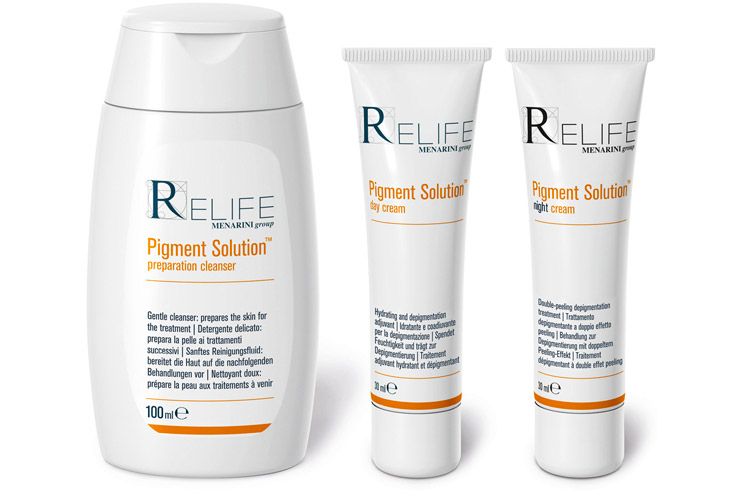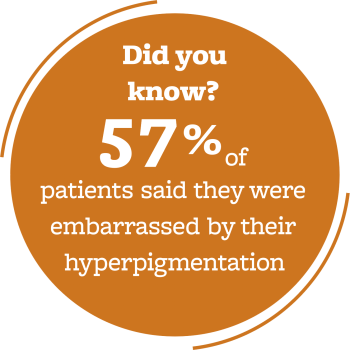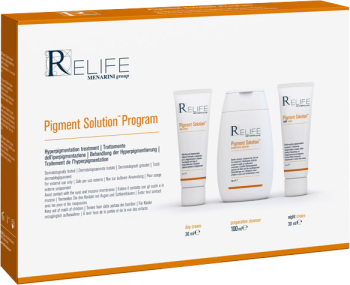Spot on

Hyperpigmentation is an umbrella term used to describe areas of uneven colour on skin. This skin condition is common and can be divided into: melasma; post-inflammatory hyperpigmentation; age spots (or sunspots); and freckles.
Age spots
Age spots are caused by overactive pigment cells. Ultraviolet (UV) light speeds up the production of melanin which gives our skin its colour. Over time, age spots appear when melanin becomes clumped together, or is produced in high concentrations.
Freckles
Ephelides, or freckles as they are better known, increase when exposed to sunlight. This type of hyperpigmentation is inherited.
Melasma
Melasma is a commonly acquired form of hyperpigmentation that typically affects facial skin and is often referred to as ‘the pregnancy mask’. This condition is more common in women than men and occurs more frequently in people who tan easily, than fair skin types, or very dark skin. The cause is complex and thought to be linked to family history, sun exposure, and hormones, including pregnancy hormones, and the use of contraceptives, certain medications and fragranced personal products. The most common distribution pattern of melasma is centro-facial or the midface (50-80% of presentation), involving the forehead, cheeks, nose and upper lip. Melasma can be divided into epidermal (on the outer layer of the skin), dermal (in the deeper layers of the skin) and mixed types, which depends on the level of increased melanin in the skin. Epidermal melasma is obvious in appearance with well-defined borders that responds favourably to treatment. Dermal and mixed melasma can vary in colour and presentation and have a poorer response to treatment.

Post-inflammatory hyperpigmentation
This particular type of hyperpigmentation occurs when melanin is left behind after an injury to the skin. The process of inflammation increases the speed at which melanin is produced and transferred. Examples of injuries that may cause hyperpigmentation includes burns, acne, eczema and friction.
Management
Fortunately, there are a number of ways to improve the appearance of hyperpigmentation. Firstly, and most importantly, people who experience hyperpigmentation should be ‘sun smart’ between the 1st of March to the end of September every single year. This is due to the role that UV exposure plays in hyperpigmentation. Being ‘sun smart’ involves wearing a high factor sunscreen, which should be an SPF 30 or 50 with the equivalent UVA protection. Wear a broad brimmed hat and sunglasses and stay in the shade where possible.
Kojic acid is an ingredient that can be derived from fungi and has the ability to penetrate various layers of the skin and inhibit melanin production.
Glycolic acid is an alpha-hydroxy acid, that is derived from sugar cane, which can penetrate skin cells due to its small size. It also removes the lipids that hold dead skin cells together, gently exfoliating the skin.
It is very important to use topical options that are effective but gentle, as injury to the skin can worsen hyperpigmentation. It is advisable to attend an accredited dermatologist if embarking on laser or other cosmetic procedures to address hyperpigmentation issues.

- Pigment Solution Program is a 3-in-1 kit that is a clinically proven effective, non-medical program, for hyperpigmentation and can be used as a regular daily programme.
- Pigment Solution preparation cleanser contains a blend of soothing ingredients formulated to gently cleanse and ready the skin.
- Pigment Solution day cream contains vitamin A to promote cell renewal, kojic acid to inhibit the production of new melanin and thereby lighten the darker patches, Aquaxyl to reduce trans-epidermal water loss, and vitamin E to protect the skin from free radicals.
- Pigment Solution night cream evens out pigmentation using a double peeling effect: chemical + mechanical, combining glycolic acid and kojic acid with biodegradable scrubbing beads.